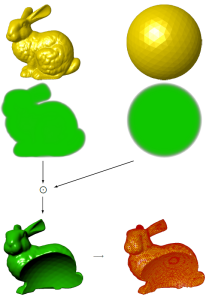
A long-running side project has recently come to fruition: My master’s thesis in the realm of medical physics got accepted! You can find the full (German) text under the prosaic title “Vergleich von Volumenmodellen” in the publications section on this site. No surprise, it’s dealing with 3D graphics – I used the chance to have a peek at a few interesting problems around volume representations.
The numerous
representations of three-dimensional objects fall into two broad
categories: surface models and volumetric models. Depending on the
application, one typically chooses one or the other. Triangles meshes,
for instances, allow for extremely fast visualization of surfaces on
modern PC hardware. In medical imaging and scientific visualization,
though, volumetric data is often prevalent.
Since many algorithms
are using either surfaces or volume data as input, it is often
necessary to convert between different representations to perform
desired operations on a data set. Mathematically, the task corresponds
to finding an implicit form for a parametric surface description, or
vice versa.
In this thesis, I am discussing the connections
between triangles meshes, and different volumetric shape
representations: binary voxel grids, discretized distance fields, and
tetrahedral lattices. Algorithms for volume visualization, conversion
between representations, and for making cuts and selections are
demonstrated. In the practical implementation, a focus was put on making
use of current GPU-based techniques to speed up not only visualization,
but also the geometric algorithms.
